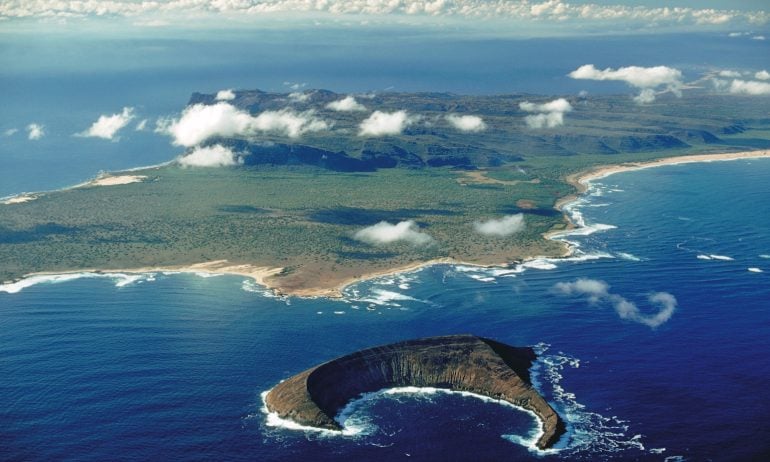6 Things to Know About Hawaii’s Smaller Islands

Many or all of the products featured here are from our partners who compensate us. This influences which products we write about and where and how the product appears on a page. However, this does not influence our evaluations. Our opinions are our own. Here is a list of our partners and here's how we make money.
Most travelers know about Maui, Oahu, Kauai and Hawaii (the Big Island) especially since they’re so popular with tourists. But many probably don't know that the state of Hawaii is a chain of islands spread out across the Pacific Ocean.
Here's a look at some key facts about small Hawaii islands, including those that are privately owned and others that are part of some of the largest protected marine areas in the world.
6 things to know about Hawaii’s small islands
1. There are 137 islands in total
Although there are just eight islands that make up the majority of Hawaii, the chain is actually much larger. The total land area of the state is about 6,423 square miles and includes 137 islands.
The size of these islands varies. The biggest, the island of Hawaii (colloquially known as the Big Island) is more than 4,000 square miles. It also includes 63% of the state's landmass.
Of the smaller islands of Hawaii, you’ll find tiny strips of land that barely peek out over the water’s edge, barren rocks jutting out of the ocean and plenty of uninhabited atolls. Among the smallest is Gardner Pinnacles, which is in the Northwestern Hawaiian Islands and consists of two pinnacles of volcanic rock totaling five acres in size.
» Learn more: The best travel credit cards right now
2. Some small Hawaiian islands are privately owned
It’s not often that you hear about someone owning an entire island, but such is the case with Ni’ihau. It’s the seventh smallest of Hawaii’s eight main islands and is owned by a single family.
Don’t worry if this sounds too fantastic to be true. In 1864, Elizabeth Sinclair purchased the island of Ni’ihau from King Kamehameha IV for a sum of $10,000. It has since been passed down through the family and remains in their possession today.
Larry Ellison, the co-founder of software company Oracle, also owns most of Lanai. He purchased 98% of the island for an estimated $300 million in 2012 and has lived there full-time since 2020.
» Learn more: 6 airlines that fly to Hawaii
3. Not all islands are open to the public
While most of Hawaii’s larger islands are open to tourism, there are quite a few where visitors aren’t welcome.
Ni’ihau doesn’t allow tourists, and although it has a population of about 160, they are all — with the exception of the Sinclair/Robinson family — native Hawaiians.
Kahoʻolawe is the smallest of the main Hawaiian islands and is similarly unavailable for visits. Despite its proximity to the island of Maui (it's just six miles away), Kahoʻolawe isn't home to residents or resorts. This is because of its history: it first served as a penal colony and later became a bombing range for the Navy. Although control has since reverted to the state of Hawaii, it remains unsafe and completely uninhabited.
The smaller islands of Hawaii that are open to visitors are Lanai and Molokai. Lanai has three hotels (two of which are luxurious Four Seasons Resorts) for overnight visits, but it's also a popular day trip option from Maui by ferry or plane. Molokai is the least-visited Hawaiian island. It has more hotel options than Lanai, but it doesn't have a lot of tourism infrastructure like tour companies and adventure excursions.
» Learn more: The best island to visit in Hawaii for the first time
4. Most small islands are uninhabited
Although it may seem obvious, many of Hawaii’s 137 islands are uninhabited. Most of the state’s population resides on seven of its eight main islands:
Hawaii.
Kauai.
Lanai.
Maui.
Molokai.
Ni’ihau
Oahu.
Kahoʻolawe, as noted previously, remains uninhabited.
This can also be seen in Hawaii’s vast marine reserves. The Hawaiian Islands National Wildlife Refuge is a part of the larger Papahānaumokuākea Marine National Monument, as is the Midway Atoll National Wildlife Refuge.
Within the refuge are atolls and islands filled with endemic wildlife. While in the past it was possible to visit some of these islands, these days the only people who live in the area are specially permitted researchers.
» Learn more: The best times to visit Hawaii
5. The smallest islands only appear at low tide
As if Hawaii wasn’t already interesting enough, did you know that its landscape is always changing? Because its terrain is so close to sea level, it’s highly susceptible to the effects of the tide.
Maro Reef, which is located in the Papahānaumokuākea Marine National Monument, contains the smallest island within Hawaii’s borders. At just one acre of land among 478,000 acres of underwater coral reef habitat, this island disappears and reappears with the tide.
» Learn more: How to island hop in Hawaii
6. New islands are still forming
All of Hawaii’s islands were formed by volcanoes that began from the ocean floor. Some of these are still active and can be visited in national parks, while others are in the process of developing new islands.
Loihi is Hawaii’s newest island and as of yet is still quite small. It’s currently 3,000 feet underwater but is growing taller as its volcano continues to erupt. Scientists expect it to break out of the water in about 50,000 years.
» Learn more: Save on Hawaii travel even as demand soars
If you want to know about the small islands of Hawaii
The Hawaii that most people are familiar with is where most of the landmass, population and tourist activities are located. After all, these islands have numerous direct flights from the continental U.S. and provide plenty of accommodations for visitors.
But with 137 islands, islets and atolls, there’s literally much more to Hawaii than its biggest islands.
How to maximize your rewards
You want a travel credit card that prioritizes what’s important to you. Here are our picks for the best travel credit cards of 2024, including those best for:
Flexibility, point transfers and a large bonus: Chase Sapphire Preferred® Card
No annual fee: Bank of America® Travel Rewards credit card
Flat-rate travel rewards: Capital One Venture Rewards Credit Card
Bonus travel rewards and high-end perks: Chase Sapphire Reserve®
Luxury perks: The Platinum Card® from American Express
Business travelers: Ink Business Preferred® Credit Card
on Chase's website
1x-5x
Points60,000
Pointson Chase's website
1.5%-6.5%
Cashback$300
2x-5x
Miles75,000
Miles




